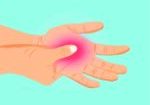Carpal Tunnel Syndrome: How does traditional hand therapy compare with neurodynamic therapy?
Filed under Treatments
Hamzeh, H., Mohammad, M., Alghwiri, A., & Hawamdeh, Z. (2021). The long-term effect of neurodynamics vs. exercise therapy on pain and function in people with carpal tunnel syndrome: A randomized parallel-group clinical trial. Journal of Hand Therapy, 34, 521-530.
The Skinny:

Carpal tunnel is the most common peripheral nerve compression problem. There is now some evidence supporting conservative management over surgical. This makes it a reasonable, potentially cost-saving option over surgery. There is limited information as to which conservative options are the most beneficial. This study looked to compare two different therapy approaches, including traditional exercise therapy and neurodynamics therapy. Hand Therapy for Carpal Tunnel Syndrome Exercises included nerve glides, tendon glides, and soft tissue mobilization vs. neurodynamic therapy, which included using specific manual techniques to change the mechanical characteristic around the nerve.
In the Weeds:
A randomized parallel-group clinical trial was completed. Twenty patients were in the traditional group, and twenty-one patients were in the neurodynamics group. Both groups completed a 60-minute treatment session per week and were prescribed daily exercises depending on if they were in the traditional vs. neurodynamic group. Please see the table below from the study of explanation of neurodynamic activities.
Bringing it Home:

Outcome measures were obtained at the 1-month follow-up and the 6 months follow-up. Outcome measures include the Boston Carpal Tunnel Syndrome Questionnaire, QuickDash, Wrist Range of Motion, and hand Hand Grip Strength. The neurodynamics group demonstrated improvement in all outcome measures. No patient that completed the study needed surgery after treatment. Both treatment options lead to improved strength and function and decreased pain; however, the neurodynamics group showed better results in all outcome measures.
Rating:
The study would be rated 4/5. There was no comparison between no treatment option; therefore, we do not know how patients would have done with natural recovery. Additionally, no patients in the study had severe carpal tunnel symptoms. Also, the study size was relatively small, and it is also difficult to gauge patients’ compliance with home exercise programs.
1 Comment
Leave a Comment
More To Read
Simple but Effective Ways Hand Therapists Address Psychosocial Impacts of Upper Extremity Injuries
Although psychosocial factors are often not formally assessed during an evaluation in those with upper extremity injuries, the therapist often informally assesses these during and after treatment sessions. Sustaining an upper extremity injury can be a physically and emotionally challenging experience. Beyond the physical pain and limitations, these injuries can profoundly impact an individual’s psychosocial…
Read MoreHow much pain should a patient have during and after therapy?
How much pain should a patient have during and after therapy? As we all know pain is somewhat subjective. It can be hard to determine how much pain a patient should experience with the type of injury as well as the type of therapy intervention and hand pain treatment. The saying of “no pain, no…
Read MoreScar Management in Hand Therapy
Hand therapists may feel they are in a constant battle with scar tissue. It can limit ROM, cause pain, impede other structures, and leave a less than desirable appearance. Scar tissue starts forming as early as 2 weeks after an injury and can continue forming for up to 2 years. The earlier action is taken…
Read MoreHand Therapy Marketing 101
Marketing 101 – 5 Tips for Your Therapy Clinic Confession: I hate marketing. It’s my least favorite part of my job. It is so hard to open yourself up to that much rejection but still stay positive. It feels like the professional version of blind dating, except the other person probably already has a significant…
Read MoreSign-up to Get Updates Straight to Your Inbox!
Sign up with us and we will send you regular blog posts on everything hand therapy, notices every time we upload new videos and tutorials, along with handout, protocols, and other useful information.







Did the groups also wear night splints ?